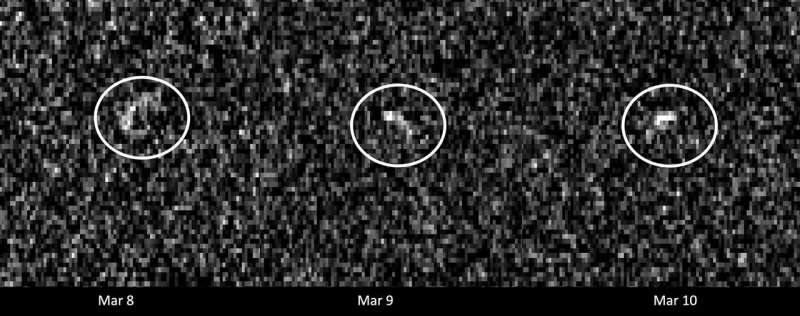This article has been reviewed according to Science X's editorial process and policies. Editors have highlighted the following attributes while ensuring the content's credibility:
fact-checked
trusted source
proofread
NASA asteroid sampling mission renamed OSIRIS-APEX for new journey

The former OSIRIS-REx spacecraft sets off on a journey to study asteroid Apophis and take advantage of the asteroid's 2029 flyby of Earth, the likes of which hasn't happened since the dawn of recorded history.
At the end of a long-haul road trip, it might be time to kick up your feet and rest awhile—especially if it was a seven-year, 4 billion-mile journey to bring Earth a sample of asteroid Bennu. But OSIRIS-REx (Origins, Spectral Interpretation, Resource Identification and Security—Regolith Explorer), the NASA mission that accomplished this feat in September, is already well on its way (with a new name) to explore a new destination.
When OSIRIS-REx left Bennu in May 2021 with a sample aboard, its instruments were in great condition, and it still had a quarter of its fuel left. So instead of shutting down the spacecraft after it delivered the sample, the team proposed to dispatch it on a bonus mission to asteroid Apophis, with an expected arrival in April 2029. NASA agreed, and OSIRIS-APEX (Origins, Spectral Interpretation, Resource Identification, and Security—Apophis Explorer) was born.
A Rare Opportunity at Apophis
After considering several destinations (including Venus and various comets), NASA chose to send the spacecraft to Apophis, an "S-type" asteroid made of silicate materials and nickel-iron—a fair bit different than the carbon-rich, "C-type" Bennu.
The intrigue of Apophis is its exceptionally close approach of our planet on April 13, 2029. Although Apophis will not hit Earth during this encounter or in the foreseeable future, the pass in 2029 will bring the asteroid within 20,000 miles (32,000 kilometers) of the surface—closer than some satellites, and close enough that it could be visible to the naked eye in the Eastern Hemisphere.
Scientists estimate that asteroids of Apophis' size, about 367 yards across (about 340 meters), come this close to Earth only once every 7,500 years.
"OSIRIS-APEX will study Apophis immediately after such a pass, allowing us to see how its surface changes by interacting with Earth's gravity," said Amy Simon, the mission's project scientist based at NASA's Goddard Space Flight Center in Greenbelt, Maryland.
Apophis' close encounter with Earth will change the asteroid's orbit and the length of its 30.6-hour day. The encounter also may cause quakes and landslides on the asteroid's surface that could churn up material and uncover what lies beneath.
"The close approach is a great natural experiment," said Dani Mendoza DellaGiustina, principal investigator for OSIRIS-APEX at the University of Arizona in Tucson. "We know that tidal forces and the accumulation of rubble pile material are foundational processes that could play a role in planet formation. They could inform how we got from debris in the early solar system to full-blown planets."
Apophis represents more than just the opportunity to learn more about how solar systems and planets form: As it happens, most of the known potentially hazardous asteroids (those whose orbits come within 4.6 million miles of Earth) are also S-types. What the team learns about Apophis can inform planetary defense research, a top priority for NASA.
OSIRIS-APEX: Travel Itinerary
By April 2, 2029—around two weeks before Apophis' close encounter with Earth— OSIRIS-APEX's cameras will begin taking images of the asteroid as the spacecraft catches up to it. Apophis will also be closely observed by Earth-based telescopes during this time. But in the hours after the close encounter, Apophis will appear too near the sun in the sky to be observed by ground-based optical telescopes. This means any changes triggered by the close encounter will be best detected by the spacecraft.
OSIRIS-APEX will arrive at the asteroid on April 13, 2029, and operate in its proximity for about the next 18 months. In addition to studying changes to Apophis caused by its Earth encounter, the spacecraft will conduct many of the same investigations OSIRIS-REx did at Bennu, including using its instrument suite of imagers, spectrometers, and a laser altimeter to closely map the surface and analyze its chemical makeup.
As an encore, OSIRIS-APEX will reprise one of OSIRIS-REx's most impressive acts (minus sample collection), dipping within 16 feet of the asteroid's surface and firing its thrusters downward. This maneuver will stir up surface rocks and dust to give scientists a peek at the material that lies below.
Although the rendezvous with Apophis is more than five years away, the next milestone on its journey is the first of six close sun passes. Those near approaches, along with three gravity assists from Earth, will put OSIRIS-APEX on course to reach Apophis in April 2029.
What OSIRIS-APEX will discover about Apophis remains to be seen, but if the mission's previous incarnation is any indication, surprising science lies ahead. "We learned a lot at Bennu, but now we're armed with even more questions for our next target," Simon said.
Provided by NASA's Goddard Space Flight Center





















